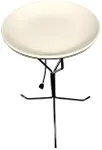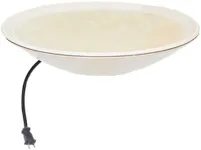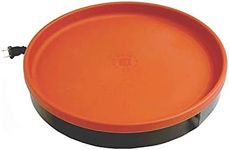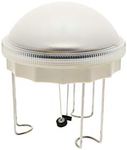Buying Guide for the Best Heated Bird Baths For Winter
Choosing the right heated bird bath for winter is essential to ensure that birds have access to fresh water even in freezing temperatures. A heated bird bath can attract a variety of birds to your yard, providing them with a vital resource and giving you the pleasure of birdwatching. When selecting a heated bird bath, consider the following key specifications to find the best fit for your needs and the needs of the birds in your area.Heating ElementThe heating element is the component that keeps the water from freezing. It is important because it ensures that birds have access to liquid water even in the coldest weather. Heating elements can be built-in or separate. Built-in elements are integrated into the bird bath, making them more convenient and often more efficient. Separate elements can be added to existing bird baths but may require more maintenance. Choose a built-in heating element for ease of use, or a separate one if you already have a bird bath you love.
MaterialThe material of the bird bath affects its durability, appearance, and how well it retains heat. Common materials include plastic, metal, and concrete. Plastic is lightweight and often more affordable, but it may not be as durable in extreme cold. Metal heats up quickly and is durable, but it can be heavy and may rust over time. Concrete is very durable and retains heat well, but it is also heavy and can be difficult to move. Choose a material based on your climate, the bird bath's location, and your preference for maintenance and aesthetics.
Size and DepthThe size and depth of the bird bath determine how many birds can use it at once and how much water it can hold. A larger bird bath can accommodate more birds and requires less frequent refilling, but it also takes up more space. The depth should be shallow enough for birds to bathe safely, typically no more than 2 inches deep. If you have a small yard or limited space, a smaller bird bath may be more suitable. Consider the number of birds you expect to visit and the available space when choosing the size and depth.
Mounting OptionsMounting options refer to how the bird bath can be installed or placed. Common options include ground baths, pedestal baths, and hanging baths. Ground baths are easy to access for birds and can be placed anywhere, but they may be more susceptible to predators. Pedestal baths are elevated, making them safer from ground predators and easier to view. Hanging baths can be placed in trees or on hooks, providing a safe and space-saving option. Choose a mounting option based on your yard layout, safety considerations, and where you want to observe the birds.
Thermostat ControlThermostat control regulates the temperature of the water, preventing it from getting too hot or freezing. This feature is important for maintaining a consistent water temperature, which is crucial for the birds' safety and comfort. Some bird baths come with built-in thermostats, while others may require an external thermostat. Look for a bird bath with a built-in thermostat for convenience, or consider adding an external one if you need more precise temperature control.
Ease of CleaningEase of cleaning is an important consideration because bird baths need to be cleaned regularly to prevent the buildup of algae, bacteria, and debris. Look for bird baths with smooth surfaces and removable parts that make cleaning easier. Some models have non-stick coatings or are designed to be dishwasher safe. Choose a bird bath that you can easily clean to ensure it remains a healthy and attractive water source for birds.













